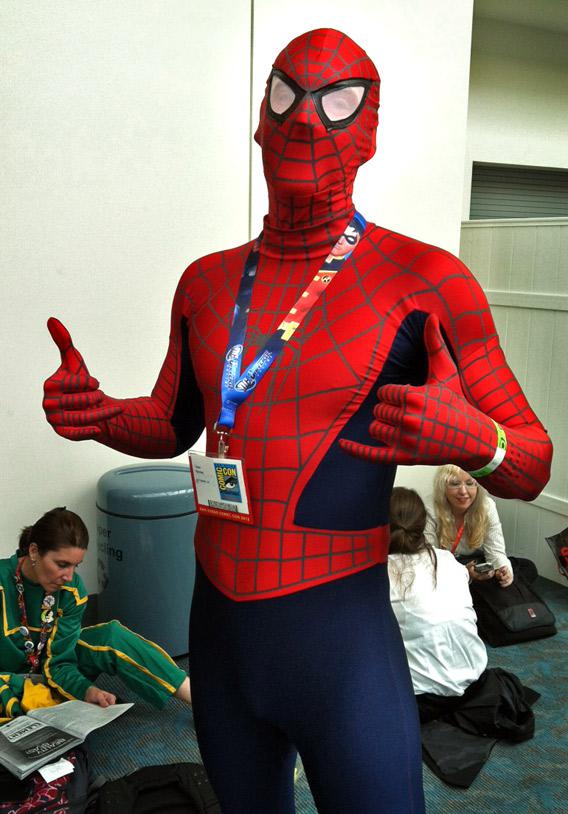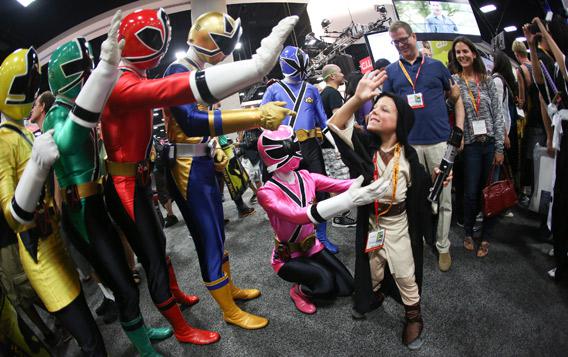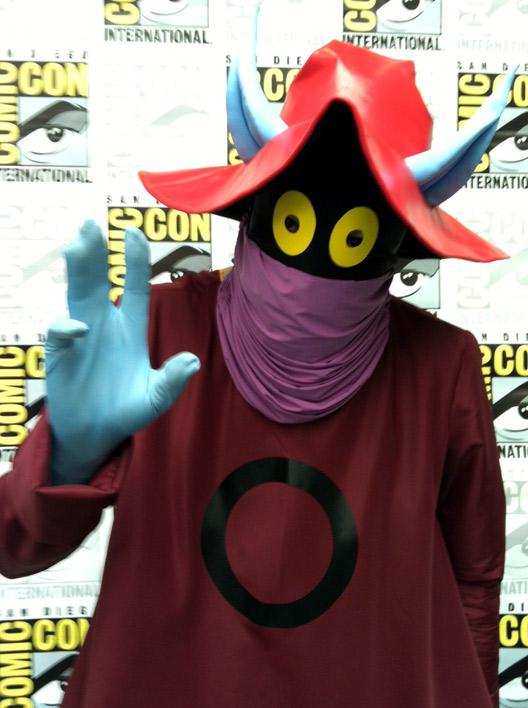SAN DIEGO—Thursday afternoon’s Comic-Con panel on the sociology of cosplay began with several bits of useful advice. (“Don’t go for Optimus Prime as your first costume. You’ll never nail it.” “Be nice to each other, because everybody else always treats us like freaks.”) But it soon morphed into a very large group therapy session.
“It’s really hard to run in armor,” a man dressed as some sort of outerspace soldier lamented with a sigh. “It’s impossible for me to get anywhere in a hurry.” The crowd murmured in assent.
“People forget that we’re human beings,” said a woman dressed as something decidedly un-human. “They keep wanting to take photos of us no matter what. They hover over us while we’re eating. They think we don’t need to go to the bathroom.”
Here I disagree. I’m well aware that cosplayers take bathroom breaks. In fact, there are few things in life I find more entertaining than watching a man in a Thor costume emerge from a toilet stall, refastening his breastplate, his Asgardian warhammer tucked beneath one arm. Likewise Cylons, Morlocks, and Jawas standing at urinals. And oh, look, there’s the Joker blowdrying his hands.

Photo by Seth Stevenson.
In my mind, this is Comic-Con’s greatest gift to the gawking attendee. A chance to live in a fantasy world rendered with unprecedented realism. A world in which the imaginary characters drink diet sodas, make cell phone calls, and defecate.
Just before I traveled out here, I asked a friend who’s a sci-fi fan what he might dress up as, were he to try his hand at cosplay. “Not one of the superheroes,” he said. “Maybe a Stormtrooper, I guess. One of the anonymous guys at the edge of the action. The ones who just sort of keep the fictional universe humming.” Whatever you may think of Comic-Con’s cosplayers, they certainly keep the Comic-Con universe humming. Without them, all you’ve got is a herd of schlumpy people waiting in lines to watch movie trailers. It wouldn’t be nearly as fun—as rowdy, as singular—if the cosplayers weren’t here.
And believe me, they’re here. The more sober-minded Comic-Con-ers complain about the amount of ink the cosplayers get, but the fact is they have a substantial presence. They’re impossible to ignore. My rough estimate is that at least 10-15 percent of the people I see here are elaborately costumed. It serves as a sort of shibboleth. Or mating call. “What’s up, Perry the Platypus!” shouted a young dude standing in line behind me for an upcoming panel. A cute teen girl dressed up as the Phineas and Ferb character beamed at having had her costume recognized. The dude eyed her longingly as she strolled down the hall, fleshy tail swaying behind her.
Over fro-yos at the Pinkberry across the street from the convention center—seemingly the one place in greater San Diego this week where it is possible to converse uninterrupted by the groans of limping zombies—I asked clinical psychologist Dr. Robin Rosenberg to tell me what cosplay is really all about. Rosenberg has been interviewing cosplayers for years, analyzing their motivations. She feels that dressing up like a Dalek can be a form of self-administered mental health treatment.
“It’s a lot like cognitive behavioral therapy,” says Rosenberg. In CBT, a therapist will ask a patient to try on a desirable persona as a sort of practice run. An insecure patient might find a situation where the stakes are low and then make a concerted effort to act brash and outgoing. The goal is to become accustomed to that feeling and know it lives within you. Ideally, you can summon it later, in times of stress. Wearing a costume might instantly turn you into a focus of attention—a role shy cosplayers are uncomfortable with in their plainclothed lives—but it lets you experiment with a different attitude while remaining hidden behind a mask.

Photo by Chelsea Lauren/Getty Images for Saban Brands.
Rosenberg’s theory was bolstered by comments I heard at the cosplay panel. “It forces you to be looked at,” said the moderator, who was dressed as Wonder Woman. “But I almost feel more comfortable in my skin when I’m wearing my costume. I put my shoulders back, and I keep my head up.” Among the benefits of cosplay listed on her Powerpoint slide: “making new friends” and “improving social skills.”
Some cosplayers, known as “real life superheroes,” push the fantasy further. A Seattle man dubbing himself Phoenix Jones has dabbled in amateur crimefighting. Jones costumes himself in body armor and a mask and patrols the city hunting for miscreants to foil. Results have been mixed: Jones is a real-life local hero to some—but he’s also gotten himself arrested for what might have been an ill-advised spree of indiscriminate pepper spraying.

By Seth Stevenson.
Vigilantes aside, cosplaying seems rather harmless. And before you chuckle at the cosplayers, pause to realize that we all have alter egos. We all adopt personas for various contexts. “Secret identities are a continuum,” as Rosenberg puts it. When you don a business suit instead of your usual hoodie, it is with the expectation that strangers will perceive you differently. It’s likely that you yourself will behave somewhat differently, as well.
Personally, I’ve never been interested in disguising myself as a superhero or an orc. But during my talk with Rosenberg, I suddenly recalled a horrifying sartorial moment from my past. In high school, I sometimes wore suspenders as an homage to Michael Steadman—my favorite character on the TV show Thirtysomething. If there’s anything lamer than dressing up as a wizard from a fantasy film franchise, it’s dressing up as a yuppie executive from a middlebrow dramedy.
So I salute you, cosplayers. Keep on trucking—by which I mean keep on heating and molding vast quantities of Wonderflex. Or just keep things simple, if you like. My favorite Comic-Con costume so far was one I spotted on a woman in her 60s. She had on regular clothes, but she wore a large, hand-lettered cardboard sign that hung from her neck. It said: “NATALIE PORTMAN IN THOR.”
